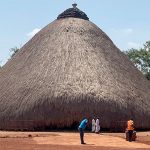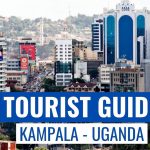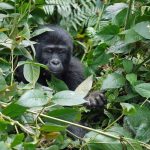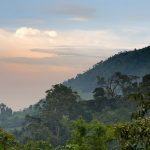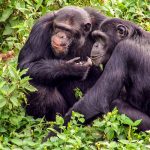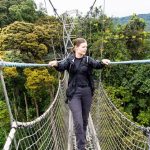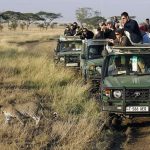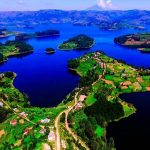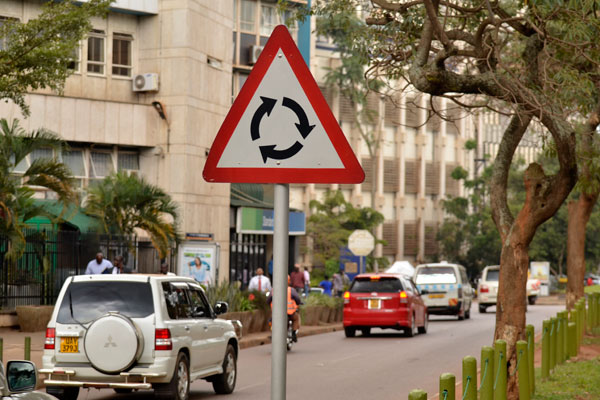Remarkably ideal for gorilla trekking, Mgahinga Gorilla National Park is found in a far-flung southwestern Uganda, neighboring Rwanda in the south and Democratic Republic of Congo (DRC) in the west. With a geographical coverage of 33 square kilometers, this is Uganda’s smallest national park but jealously protected given its unique features that you will not find elsewhere in the country.
Situated 14kms from Kisoro town, Mgahinga National Park covers the slopes of the three northern largely Virunga Volcanoes; Mountain Muhavura (4,127 m), Mountain Gahinga (3,474 m) and Mountain Sabinyo (3,645 m). The three countries, Uganda, Rwanda and DR Congo, each takes care of its own portion of the Virungas, whereby Uganda is for Mgahinga National Park, Rwanda for Parc National des Volcans and DR Congo for Parc National des Virunga in that order. The three parks jointly form the Virunga Conservation Area (VCA) that occupies an area of 434-sq km, out of which, Mgahinga is has a share of 33.7 sq. km, constituting 8% of the VCA. The entire Mgahinga Park is in Bufumbira County in Kisoro District.
Mgahinga Gorilla National Park is made up of moderately forested slopes of three extinct volcanoes. From far away, the vast cones of the Virunga volcanoes govern the panorama and manifest as you approach. Once you arrive at the park you can get a considerable synopsis of the vicinity by walking up the standpoint, just 15 minutes from Ntebeko Gate. The park has an immense environmental value given that during the climatic changes of the Pleistocene ice ages, mountains like the Virunga provided a place of protection for mountain plants and animals that ascended and descended the slopes as climate became warmer or cooler. The Virungas are a habitation to a large diversity of wildlife; including about half the number of the planet’s gravely endangered mountain gorillas.
Things to Do in Mgahinga National Park
Mgahinga National Park boasts of roughly 39 mammal and 79 bird species. Animals including the elephants, leopards, buffalos and warthogs/bush pig are once in a while seen at the park. However, the mainly notable and prevalent inhabitants of the park are the Mountain Gorillas.
Gorilla Tracking in Mgahinga National Park
Gorilla Tracking is the most important amazing tourist activity in Mgahinga Gorilla National Park. The habituated gorilla in this park is called the Nyakagezi, which consists of 9 members, 2 silverback gorillas, 3 adult females, 2 juveniles and 2 infants. Gorilla trekking is a rigorous experience that can last a day long. The track guide takes you through the gorilla’s world, explaining at length the genetic and behavioral aspects of the gorillas. Important to note, while you have a very good opportunity of seeing gorillas, succeeding on this is not definite. They are wild animals with no permanent schedule, and finding them requires the skill and experience of the guides.
The trackers and guides have lent a hand in habituating the gorilla groups and are on familiar terms with them closely. They will take you to the spot where they left the gorillas the day before. Prior to departure for trekking, the guides tell you how long the walk may take. As you are walking, be open to ask the guides to rush if they are going too speedy and if you need a rest to do so briefly. Feel at ease to stop and stare at birds or flowers, the guide will make sure that you don’t get left behind. The trekking exercise can be tedious; therefore it is good to have physical fitness.
Hiking
Moving from Mgahinga national park trekkers can get higher above to Mt. Sabinyo which 3645metres, Mt Gahinga 3474 metres and Mt. Muhavura 4127 metres above sea level.
Volcano Climbing of Mt. Sabyinyo (366m)
The ‘Old man’s teeth’, like an old man, time has weather-beaten Mt. Sabyinyo’s crown. Seeing the ‘Old man’s teeth’ on the top of Mt Sabinyo is another superb exploration. This volcano has 3 challenging peaks to climb. Climbing the mountain takes one up a edge along the eastern side of the climb to the peak. If you are to continue, the climb to the peak 11 involves walking a ridge with breath-taking drops into gorges of Rwanda and Uganda, a dual experience you will achieve here and enjoy. And the hike up to the peak 111 is steep with several ladders and mush scrambling. Your hands have to get dirty en-route to peak111! But once you reach the top, you will be in Rwanda, Democratic Republic of Congo and Uganda, what a triple memorable experience this one is!!! The journey takes about eight hours round trip to cover the 14km stretch.
Mount Gahinga (3474m)
As you are on your way to the park, you will come across small piles of stones in the garden fields locally known as ‘Gahinga’. Mount Gahinga is pretty bigger than the average ‘gahinga’ but sitting next to Mount Muhavura which makes it turn out to be visibly small. Here, a six-hour hike round expedition goes through a good model of a pure Bamboo jungle. Mt. Gahinga at one time had a Crater Lake on its peak but time has altered it into a flourishing swamp which is 8km away.
Mount Muhavura (4127m)
One can well see this volcano from all over Kisoro which acts as a point. The emblematic cone-shaped Mountain provides some of the best views in the Uganda. For the most part of the hiking passes a rocky exterior enclosed by grasses and small vegetation. Hikers are presented with the sight of the Virunga volcanoes, Lake Edward in queen Elizabeth National Park, Bwindi and the Peak of Rwenzori Mountain once at the top of Muhavura. The trekking exercise takes about 8 hours round trip covering 12km. One is advised to base camp at the Muhavura campsite the night before hiking because the place has no facilities hence you need a tent, water, food and sleeping stuffs amongst others.
3. Cave Exploration (The Garama cave)
This is one of the caves where once upon a time the crafty Batwa warriors lived and fought their neighbors, the Bantu. The distance to the cave front entrance from the park headquarters is just 3 km and takes about 4 hours. Your guide will acquaint you with the Batwa history and show you how they lived and fought out of the cave. The cave, 342m in length and 14m deep is at present occupied by bats.
– Viewing platform, it is about 800 metres from the Park gate. While on top, you will have a superior visualization of the Park and the neighboring areas. A guide is not considered necessary here and the activity is free of charge. Displaying panels at the hill point will give a quantity of information about what you can see.
– Border trail, is a free 5-hour walk that takes you first in the direction of Sabinyo. The trail goes up to the Sabinyo base for a while through fine montane forest before turning in the direction of the Congo. On your way, you will catch a fine view of Sabinyo’s gorge and peaks. When you go into Congo, you cut backside along the international border and come back to the Park Head offices which is a great segment for bird watching. Also the two rest huts along the way are excellent places for a break. Observe closely for the golden monkeys and elephants as you return. Hiking distance is 10 km.
Mgahinga Bird Watching
Mgahinga Gorilla National Park boasts of about 79 bird species, including a number of species widespread in the East Congo Montane province and these consist of the Ibis, Whydah, Speckled Mouse birds, and Fire Finch Stonechat, Grey Capped Warbler, Waxbills, and Yellow-Vented Bulbul. For the whole Virunga Conservation Area, over 295 species are prevalent to the Albertine Rift Afromontane region making up a 59% of the total of identified common species. Remember to speak to the Park Management for someone to guide you around for a good viewing of birds and travel with all your birding equipments like binoculars.
Free Birding
One can enjoy free bird watching on the edges of the park but on request. The guides will take you out from 5-6 pm if you book early by 10 am on the day you want to watch birds. Freely choose your walk direction or simply relax in the camping ground. A gentle walk along the buffalo wall towards the Congo takes you through a wetland area where Ibis, Whydah, Speckled Mousebird, and Fire Finch are found. Stonechat, Grey Capped Warbler, Waxbills, and Yellow-Vented Bulbul are common at the campground. Inquire from the guide about the best spots and take your time and move. Bird Species at Semuliki include the Broad-billed Roller, Green Wood-hoopoe, African Grey Hornbill, African Moustached Warbler, rapacious Red-necked Falcon, Black-winged Red-Bishop, White-winged Widowbird and Fawn-breasted Waxbill, Double-toothed Barbet, Yellow-throated Leaflove, Green-backed Eremomela, Piapiac, Black-chinned Quail-Finch, Red-shouldered Cuckoo-shrike and Western Violet-backed sunbird, the listing is continual. Walk on your own rate as birding needs no rapidity.
How to Reach Mgahinga National Park
Mgahinga Gorilla National Park is placed 540 kilometres Kampala, the Capital City of Uganda, which is an 8-hour long journey through Kabale to Kisoro district. Once in Kisoro Town, you can voluntarily hike to the park if you are strong enough or hire a cab to the park gate.
Where to Stay
Kisoro Town is just 14 kms to the gate of Mgahinga Gorilla National Park and offers a variety of accommodation facilities like the basic camp-site and luxurious hotels.
Popular Places where to stay include:
- Traveler’s Rest
- Mgahinga Safari Lodge
- Mount Gahinga Rest Camp
- Virunga Hotel
- Sky Blue
- Rugigana Campsite
- Omubano Hotel
- Community Camp ground with ample space for ‘ Do it you Self-Camping
If you want to stage a camp, there is more than enough space at the park gate and Mt. Gahinga Rest Camp for ‘Do it Yourself Camping’, besides that, there is also superb traditional Bandas managed by the local community.

